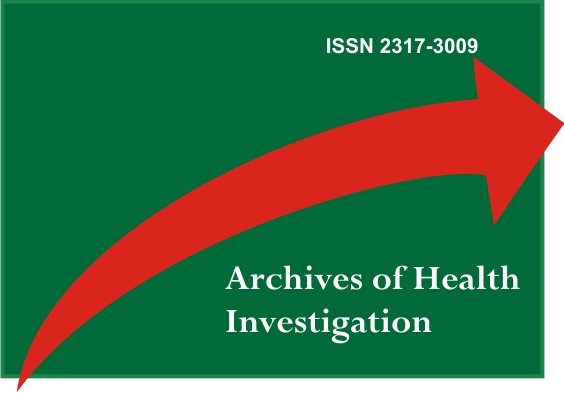Resin Infiltration in the Treatment of Enamel Hypoplasia: Case Report
DOI:
https://doi.org/10.21270/archi.v11i4.5446Keywords:
Resin Infiltration, Dental Enamel Hypoplasia, Cosmetic DentistryAbstract
Objective: this case report aims to describe the clinical the treatment of enamel hypoplasia in tooth 11, in a 23-year-old female patient, through the resinous infiltrating. Case report: briefly, the hypoplasic lesion was treated with 15% hydrochloric acid for 2 minutes. Then 99% alcohol was applied over the lesion for 30 seconds and resin infiltration for 3 minutes, followed by light curing for 40 seconds. Again, infiltrating resin was applied for 1 minute and light cured. After that, finishing and polishing were carried out with finishing cup and polishing discs, followed by a felt and paste disk. Conclusion: it can be concluded that the protocol used in this case report proved effective and produced excellent esthetic results.
Downloads
References
Muñoz MA, Arana-Gordillo LA, Gomes GM, Gomes OM, Bombarda NHC, Reis A, et al. Alternative esthetic management of fluorosis and hypoplasia stains: Blending effect obtained with resin infiltration techniques. J Esthet Restor Dent. 2013;25(1):32-9.
Sales MMS, Chisini LA, Castanheira VDS, Castro IS, Teixeira LS, Demarco FF. Non-fluorotic enamel defects in children: clinical and epidemiological aspects. Rev da Fac Odontol - UPF. 2016;21(2):251-59.
Auschill TM, Schmidt KE, Arweiler NB. Resin infiltration for aesthetic improvement of mild to moderate fluorosis: A six-month follow-up case report. Oral Health Prev Dent. 2015;13(4):317-22.
Son J-H, Hur B, Kim H-C, Park J-K. Management of white spots: resin infiltration technique and microabrasion. J Korean Acad Conserv Dent. 2011;36(1):66.
Todorova VI, Filipov IA, Khaliq AF, Verma P. Aesthetic Improvement of White Spot Fluorosis Lesions with Resin Infiltration. Folia Med (Plovdiv). 2020;62(1):208-13.
Tirlet G, Chabouis HF, Attal JP. Infiltration, a new therapy for masking enamel white spots: a 19-month follow-up case series. Eur J Esthet Dent. 2013;8(2):180-90.
Gugnani N, Pandit IK, Goyal V, Gugnani S, Sharma J, Dogra S. Esthetic improvement of white spot lesions and non-pitted fluorosis using resin infiltration technique: Series of four clinical cases. J Indian Soc Pedod Prev Dent. 2014;32(2):176-80.
Kabaktchieva R, Gateva N, Peycheva K, Dentistry DC. The role of light-induced fluorescence in the treatment of smooth surface carious lesions with icon infiltration and the result after 1 year. 2014;36-42.
Manoharan V, Kumar AS, Arumugam SB, Anand V, Krishnamoorthy, Santham Methippara JJ. Is Resin Infiltration a Microinvasive Approach to White Lesions of Calcified Tooth Structures?: A Systemic Review. Int J Clin Pediatr Dent. 2019;12(1):53-8.
Attal JP, Atlan A, Denis M, Vennat E, Tirlet G. White spots on enamel: Treatment protocol by superficial or deep infiltration (part 2). Int Orthod. 2014;12(1):1-31.
Cohen-Carneiro F, Pascareli AM, Christino MRC, Vale HF do, Pontes DG. Color stability of carious incipient lesions located in enamel and treated with resin infiltration or remineralization. Int J Paediatr Dent. 2014;24(4):277-85.
Paris S, Schwendicke F, Keltsch J, Dörfer C, Meyer-Lueckel H. Masking of white spot lesions by resin infiltration in vitro. J Dent. 2013 Nov 1;41(SUPPL.5):e28-34.
Phark J-H, Duarte Jr S, Meyer-Lueckel, Hendrik Paris S. Caries infiltration with resins: a novel treatment option for interproximal caries. Compend Contin Educ Dent. 2009;30(SpecNo 3):13-7.
Torres CRG, Borges AB, Torres LMS, Gomes IS, De Oliveira RS. Effect of caries infiltration technique and fluoride therapy on the colour masking of white spot lesions. J Dent. 2011;39(3):202-7.
Kidd EA, Fejerskov O. What constitutes dental caries? Histopathology of carious enamel and dentin related to the action of cariogenic biofilms. J Dent Res. 2004;83(Spec):C35-8.


